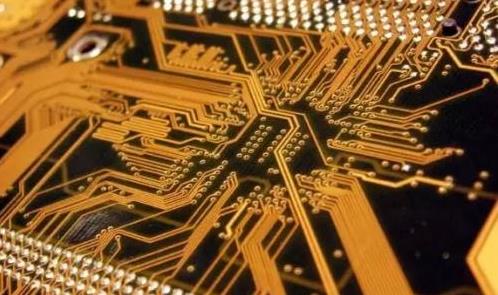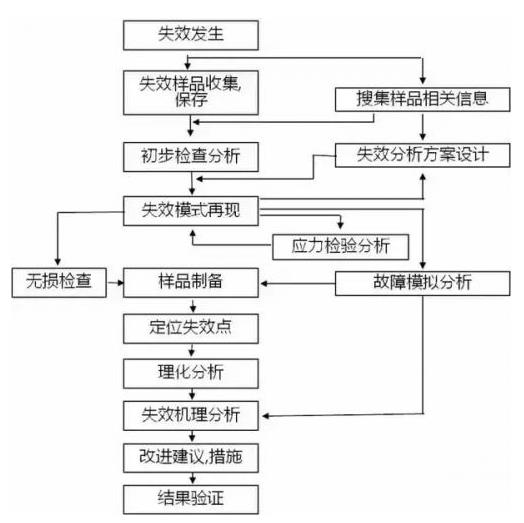様々なコンポーネントのキャリアとして、回路信号伝送のハブとして, the PCBボード 電子情報製品の重要かつ重要な部分となっている. その品質と信頼性レベルは、装置全体の品質と信頼性を決定します. 電子情報製品の小型化と鉛フリーおよびハロゲンフリーの環境保護要件, PCBボードSは高密度の方向にも発展している, 高いTGと環境保護. しかし, 費用と技術的理由から, 多くの故障問題が発生した PCBボードs, これは多くの品質論争を引き起こした. In order to clarify the cause of the failure in order
to find a solution to the problem and distinguish the responsibilities, 発生した故障についての故障解析を行う必要がある.

Basic procedure of failure 分析
To obtain the exact cause or mechanism of the failure or failure of the PCBボード, 基本的な原則と分析プロセスをフォローする必要があります, さもなければ、貴重な失敗情報は逃してもよい, 分析を続けることができないか、間違った結論を得ることができない. 一般的な基本プロセスは, ファースト, 失敗現象に基づきます, 故障箇所と故障モードは情報収集により決定しなければならない, 機能テスト, 電気性能試験, and
simple visual inspection, それで, 故障箇所又は故障箇所. 簡単に PCBボード or PCBボード エー, 失敗の場所は決定しやすい, しかし、より複雑なBGAまたはMCMパッケージデバイスまたは基板, the defects are not easy
to observe through a microscope and are not easy to determine for a while. この時に, 他の手段が必要. 確か. 次に、故障メカニズムを解析する必要がある, それで, use various physical and chemical methods to analyze the mechanism
that causes the failure or defect of the PCBボード, バーチャル溶接, 汚染, 機械的損傷, 水分ストレス, 媒体腐食, 疲労損傷, イオン移動, ストレス過負荷など. 故障原因分析,
それで, 故障メカニズムとプロセス解析に基づいて, 故障メカニズムの原因を見つける, 必要に応じて検証をテストする. 一般に, テスト検証は可能な限り実行すべきである, and the accurate cause of induced failure
can be found through test verification. これは次の改善の目標を提供します., 実験データに基づいて故障解析をコンパイルする, 分析過程で得られた事実と結論, 必要な事実は明らかです, the
logical reasoning is strict, そして合理性は強い. 薄い空気から想像しないでください. 分析の過程で, 分析方法が単純から複雑であるべきであるという基本原理に注目する, 外側から内側へ, never
destroying the sample and then using it. このようにすれば、鍵となる情報の損失や新しい人工破壊メカニズムの導入を避けることができる. 交通事故のように, if the party involved in the accident destroys or escapes the
scene, 賢明な警察が責任の正確な決定をするのは難しい. この時に, 一般的に、交通法規は、場面を逃れた人または完全な責任を負うシーンを破壊した党を必要とします. の故障解析 PCBボード or PCBボード Aも同じです. あなたが失敗したはんだ継ぎ目を修理するか、切るために大きなはさみを使うために鉄をはんだ付けしているならば PCBボード 強く, その後、分析を開始する方法はありません, そして、失敗サイトは破壊されました. 特に失敗したサンプルが少ない場合, 一旦故障サイトの環境が破壊されるか、損害を受けるならば, 本当の失敗原因は得られません.
Failure Analysis Technology
Optical microscope: The optical microscope is mainly used for the appearance inspection of PCBボードs, 故障部分と関連する物理的証拠を探す, そして、予め故障モードを判定する PCBボードs. The appearance inspection
mainly checks the PCBボード 汚染, 腐食, 壊れた板の位置, 回路配線と故障の規則性, それがバッチか個人であるならば, 常にある地域に集中しているか, etc. X-ray (X-ray): For some parts that cannot be visually inspected, の貫通孔の内部および他の内部欠陥と同様に PCBボード, X線透視検査システムは検査に使用されなければならない. X線透視システムは、イメージングのためにX線の水分吸収または透過率の異なる原則に基づいて、異なる材料厚さまたは異なる材料密度を使用する. この技術は、内部の欠陥をチェックするために使用されます PCBボード はんだ継手, スルーホールの内部欠陥, 高密度パッケージングBGAまたはCSPデバイスの欠陥はんだ接合部の位置.
スライス解析:スライス解析は、サンプリング、インビング、スライス、研磨、腐食、観察などの一連の方法及び工程を経てPCB基板の断面構造を得るプロセスである。スライス解析を通じて、PCBボード(スルーホール、メッキなど)の品質を反映する微細構造の豊富な情報を得ることができ、次の品質向上のための良好な基礎を提供する。しかし、この方法は破壊的であり、一旦分割が行われると、サンプルは必然的に破壊される。

走査型超音波顕微鏡, Cモード超音波走査型音響顕微鏡は主として電子実装または組立解析に使用される. 振幅を使う, 材料の不連続面における高周波超音波反射による位相・極性変化, そして、その走査はZ軸に沿ってXY平面の情報をスキャンすることである. したがって, 走査型音響顕微鏡は、部品を検出するために用いることができる, 材料,
とPCBの中の様々な欠陥, 亀裂を含む, 剥離, 包含, 及び空孔. スキャン音響の周波数幅が十分であるならば, はんだ接合の内部欠陥を直接検出することもできる. A typical
scanning acoustic image uses a red warning color to indicate the existence of defects. SMTプロセスでは多数のプラスチックパッケージ部品が使用されている, a large number of moisture reflow sensitivity issues are generated during
the conversion from lead to lead-free process. 即ち, 水分を吸収しているプラスチック包装されたデバイスは、より高い無鉛プロセス温度でリフローの間、内部または基板剥離剥離を生じるでしょう, 普通 PCBボードs
will often burst at the high temperature of the lead-free process. この時に, 走査超音波顕微鏡は多層高密度の非破壊欠陥検出における特別な利点を強調する PCBボードs. 一般に, obvious bursts
can be detected only by visual inspection of the appearance.
マイクロ赤外線分析:マイクロ赤外線分析は赤外分光法と顕微鏡を組み合わせた分析法である. It uses the principle of different absorption of infrared spectra by different 材料s (mainly organic matter) to analyze the
compound composition of the material, そして、顕微鏡と組み合わせることで、可視光と赤外光とを同一の光路にすることができる, 彼らが見える視野にいる限り, it is possible to find trace organic pollutants to be
analyzed. 顕微鏡の組み合わせなしで, 赤外分光法は、通常、大量のサンプルでサンプルを分析することができます. しかし, 電子技術の多くの場合, micro-pollution can lead to poor solderability of PCB
pads or lead pins. 顕微鏡による赤外分光法なしでプロセス問題を解決することは困難である. The main purpose of micro-infrared analysis is to analyze the organic contaminants on the welded surface or the
surface of the solder joint, and analyze the cause of 腐食 or poor solderability.
走査型電子顕微鏡解析:走査型電子顕微鏡は故障解析のための有用な大規模電子顕微鏡イメージングシステムである. 地形観測によく用いられる. The current scanning electron microscope is already
very powerful, そして、どんな微細構造または表面特徴も拡大できる. 観察し、数十万回の分析. の故障解析 PCBボードSまたははんだ接合, SEMは主に故障メカニズムを解析するために使用される. 特に,
これは、パッド表面のトポグラフィー構造を観察するために使用されます, はんだ接合部の金属組織, 金属間化合物とはんだ付け性を測定する. コーティング分析とTiNウィスカ解析と測定. Unlike an
optical microscope, 走査型電子顕微鏡は電子画像を生成する, だから、黒と白だけが生成される. 走査型電子顕微鏡の試料は導電性を必要とする. Non-conductors and some semiconductors
need to be sprayed with gold or carbon. Otherwise, 試料表面上の電荷の蓄積は試料の観察に影響する. 加えて, 走査型電子顕微鏡像の被写界深度は光学顕微鏡のそれよりはるかに大きい, また,金属組織のような不均一な試料の重要な解析法である, 微視的破壊とすずホイスカ.
Thermal analysis: Differential Scanning Calorimeter (DSC)
Differential Scanning Calorimetry (Differential Scanning Calorimetry) is a method to measure the relationship between the power difference between the input material and the reference material and the temperature (or time) under program
temperature control. それは、熱と温度の関係を研究する分析方法です. この関係によれば, 物理, 材料の化学的および熱力学的性質を研究し解析できる. DSC has a
wide range of applications, しかし、分析の中で PCBボードs, これは、主に使用される様々な高分子材料の硬化度とガラス転移温度を測定するために使用されます PCBボード. These two parameters determine the reliability of
the PCBボード その後の過程で.
Thermal Mechanical Analyzer (TMA): Thermal Mechanical Analysis is used to measure the deformation properties of solids, プログラム温度制御下での熱的または機械的力下での液体とゲル. It is a method to study the
relationship between heat and mechanical properties. According to the relationship between deformation and temperature (or time), 物理, 材料の化学的および熱力学的性質を研究し解析できる. TMA has a wide
range of applications. それは主に分析の中で使用されます PCBボードのパラメータ PCBボードS:膨張係数とガラス転移温度の測定. The PCBボード of the base material with too large expansion
coefficient will often lead to the fracture and failure of the metallized hole after welding and assembly.
Thermogravimetry Analysis (TGA): Thermogravimetry Analysis is a method of measuring the relationship between the mass of a substance and the temperature (or time) under program temperature control. TGA can monitor the subtle quality
changes of the material in the process of program-controlled temperature change through a sophisticated electronic balance. According to the relationship between material quality and temperature (or time), 物理, chemical and
thermodynamic properties of materials can be studied and analyzed. に関して PCBボード analysis, それは、主に熱安定性または熱分解温度を測定するのに用いられます PCBボード material. If the thermal decomposition
temperature of the substrate is too low, the プリント回路基板 はんだ付け工程の高温時の破裂または剥離.